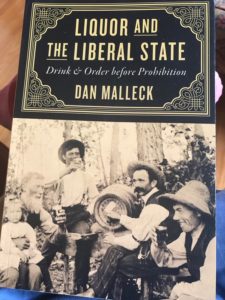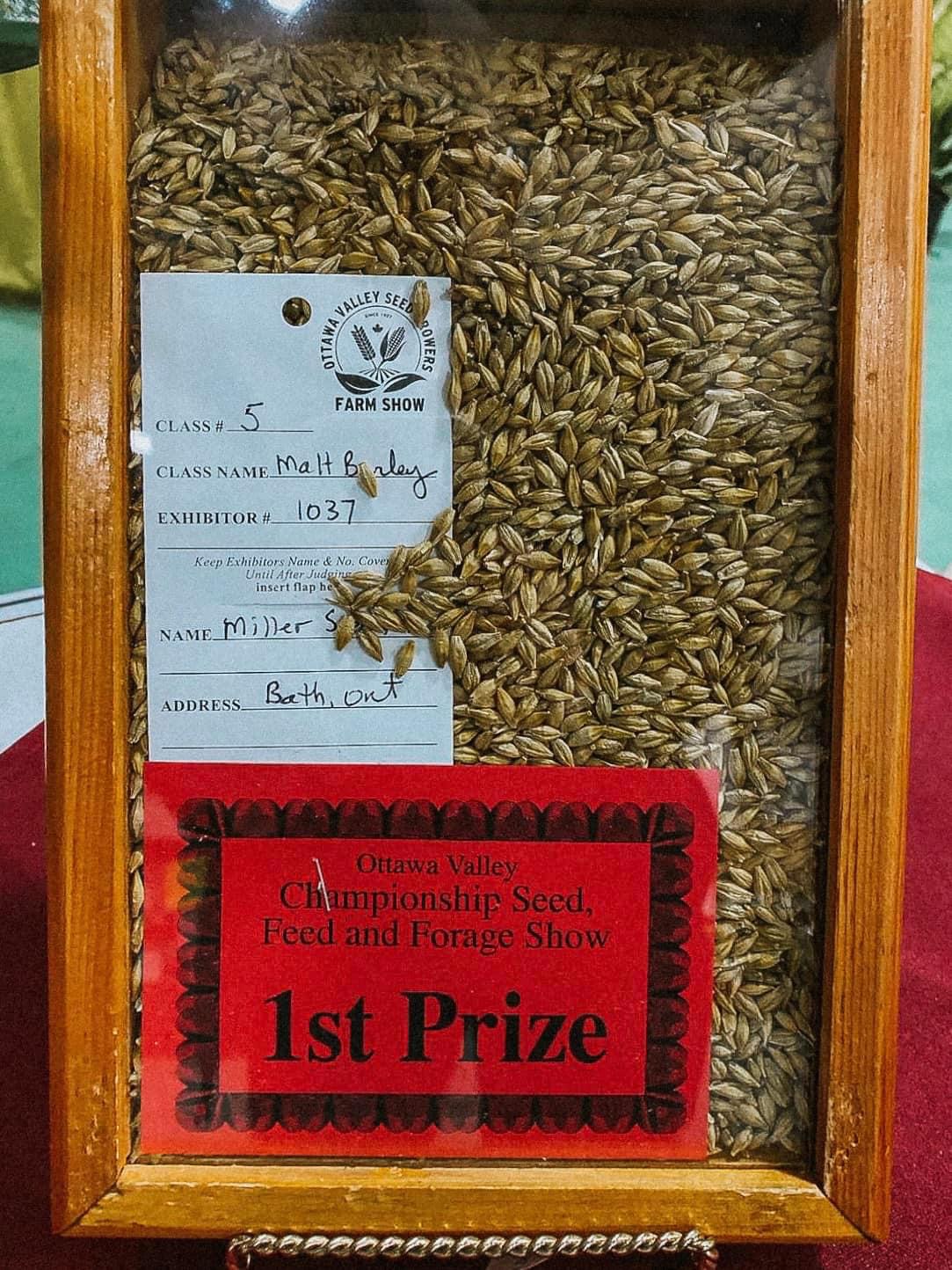 Here we are. Mid-May and… the tomatoes have had to been covered and stuck in the shed for two nights. It was +0.7C Wednesday at 6 am and -1.0C on Thursday at about the same time. Lordy. BTW, I’ve hit 60 (as I have mentioned a number of times) so I plan to say “Lordy” more. Martin, who I suspect also says “Lordy” a lot, thumbed his nose to the fear of frost and spent some time at the seaside. Withernsea, to be exact. He spotted the same thing in real life that I did in his photos: “… the pub a minor joy with comfortable seating…” Now that I’m 60 I can say what I’ve known in my heart since I was a teen. Nothing like a comfy seat. Now, I know that this may not the sort of hard hitting beer journalism that you have come to expect hereabouts but I say it is beer realism. Happy butt, happy lad.
Here we are. Mid-May and… the tomatoes have had to been covered and stuck in the shed for two nights. It was +0.7C Wednesday at 6 am and -1.0C on Thursday at about the same time. Lordy. BTW, I’ve hit 60 (as I have mentioned a number of times) so I plan to say “Lordy” more. Martin, who I suspect also says “Lordy” a lot, thumbed his nose to the fear of frost and spent some time at the seaside. Withernsea, to be exact. He spotted the same thing in real life that I did in his photos: “… the pub a minor joy with comfortable seating…” Now that I’m 60 I can say what I’ve known in my heart since I was a teen. Nothing like a comfy seat. Now, I know that this may not the sort of hard hitting beer journalism that you have come to expect hereabouts but I say it is beer realism. Happy butt, happy lad.
First up and not as happy, Lew made an interesting observation this week in his column at The Full Pint:
Failure might be on the way, because cost inputs in brewing have gone up and up, and people don’t want to see more price increases in the cooler. How can they not, when I hear from brewers about double-digit increases in packaging prices (glass, cans, kegs), 50% jumps in energy costs, and (finally) increases in labor costs. That’s why prices go up…mostly. But prices also go up sometimes because everyone’s waiting for the big brands – either in sales, or reputation and cachet – to go first, and when they do, everyone rushes to follow. That’s not collusion, they didn’t conspire to do it, it’s more like a stampede. When one buffalo starts running, pretty quickly they’re all running, because no one wants to get left behind.
It’s true that there’s price input pressure but there’s also the reality of sluggish interest in beer. Because, you know, people can run in any number of directions – including to straight to pouring other drinks in their glass. How many breweries are comfortable with the prospect of cutting output and raising prices?
Speaking of which, I had my first natural wine last weekend. My notes: “Yeasty, orange pear juice fruit, dry with light bubble and green pepper end with a little white pepper. Watery Creamsicle with mineral herb?” Perhaps not a repeat buy for me but interesting enough as experience goes. I only mention that (and not anything else like the name of the wine) as I read a piece in a newsletter called Everyday Drinking about how unpleasant natural wine fans are and I don’t want anyone showing up on my door:
Almost immediately, our natural winemaker launched into a rant. First, about the winemaker we’d just visited. “What is biodynamic anyway?” he said. “They can just buy the biodynamic preparations online.” This rant wasn’t surprising. There is possibly no group of people on earth who talk more shit about one another—behind one another’s back—than natural winemakers do. Plus, the biodynamic winemaker had already told us he’d once partnered with this guy and they’d had a “philosophical” falling out.
Yikes. Yet… is it true? Pellicle steps up to the defence of the naturalistas with a day in the life of an Australian harvest:
It is one of the rainiest seasons you’ve ever seen or heard of, and winemakers are anxiously racing against the threat of mildew and rot—the two inevitable results of rain falling on grapevines. Not to mention the birds and the kangaroos, constant predators of your fruits who find their ways past fences and through the netting, so much do they enjoy sucking the juice out of the berries or nibbling entire bunches.
Not at all unpleasantly, Eoghan guided us to an article in The Brussles Times about, what, appropriation of Belgium’s national drink by adulterous hegemonistic US craft:
The competition had a total of 24 “Belgian-style” beer categories, for which US beers took home most of the prizes. Canadian brewers also got more medals than Belgian ones for “Belgian-style” beers, receiving four prizes. “It’s been said that Belgian beer is having some difficulties on the international scene due to a lack of innovation. I think we are proving the opposite with our Seefbier, a beer style that dates back to 16th century Antwerp,” said Johan Van Dyck, founder of the Antwerp Brewing Company.
See also. Interesting use of “innovation” up there which leads us to Ron who suggests it’s a misuse and mislabelling of what is really just change:
True innovation in brewing is far rarer. Things like the adoption of the hydrometer and thermometer. Baudelot coolers. Refrigeration. Pure yeast cultures. Mash filters. Continuous fermentation. (It may have been a total disaster, but it was truly new.) Stuff that really hadn’t been done before. And genuinely transformed brewing. Most of what’s called innovation today? Mere tinkering with ingredients. While change is inevitable, it’s rarely innovation.
Speaking of which, I was there until the flavoured barrel-aging. Why can’t we respect the fundamentals? Speaking of which, the archeological record could support a Journal of Archaaeological Brewing but no one seems to want to do it.
Jeff posted a few thoughts about “innovative” collaborations in the land of good beer, a concept which long ago morphed from brewers getting together to beer writers getting their names on beer bottle labels to anytihng imaginable to… to… perhaps the unimaginable:
I may be an outlier here, but as a rule of thumb, I personally would never green-light a collab with any packaged meats product. No doubt some drinkers will cotton to the idea of a meaty brew, but are their numbers sufficient to offset those who gag at the idea? Put another way, one way to consider the potential harms and benefits of a potential collab is to ask whether people will confuse it with an April Fools joke. If the answer is even a maybe, it’s probably a poor opportunity.
And Cass posted an excellent update on the state of brewing in Syracuse, NY over at A Quick Beer:
Syracuse has an up-and-coming beer scene with many new breweries in a city that’s easy to explore. We enjoyed just a taste of Syracuse’s thriving beer scene, including pioneer Middle Ages, modern breweries such as Talking Cursive, Meier’s Creek, Buried Acorn and Bullfinch, plus checking out Syracuse’s Tipp Hill neighborhood and Seneca Street and SingleCut in nearby Manlius.
What that? NO, that’s just the blurb. He posted a video! Cass also runs the excellent (and perhaps older than this here space) The Bar Towel Forum for all your beer chatting needs. Speaking of which, the Craft Beer Channel has hit a decade of beers by video.
Health question: why does the congratulations around someone saying they are doing so well and feeling much healthier off the booze require also praising the person for also not recommending anyone else try it? Taboo?
Only tangentially related, Stan was having to be pretty blunt this week. His round up was only about the botch of a conference put on by the Brewers Association that I touched on that week – a botch which left him in less than a positive mood:
Last month I wrote, “It’s not my goal to find less pleasant stories to balance the feel good ones, but some weeks that is pretty easy.” There were stories last week that you might label “feel good,” but by the time the week ended nothing felt very good.
The Beer Nut made a few interesting observations about the state of BrewDog’s beer as well as the big surprise in beer for 2023, the battle for stout supremacy:
he first beer to catch my attention was Black Heart. BrewDog has been marketing this heavily as a Guinness substitute, and just like with Ansbach & Hobday’s London Black last year, I wanted to put that to the test. Unlike London Black, however, this one does actually meet the brief. They’ve matched the strength of Draught Guinness in Britain where it’s 4.1% ABV. They’ve got the texture spot on, while the flavour is very dry and rather boring, presenting an equivalent amount of toast and roast but lacking the tangy sourness which is Draught Guinness’s only real nod to having character. Mission accomplished, I guess, though BrewDog normally makes much more interesting beers than this. I would like to try them side by side if I ever get the chance.
David Jesudason (he of the BBC article on his new book, released yesterday) had an interesting article in his Substack newsletter Episodes of My Pub Life and prefaced it with this interesting heads up:
This article should be paid content. In fact, like last week’s article, it was commissioned but I chose to withdraw it from the publication as they wanted to change it too much from the initial brief. There’s no bad feeling about this decision and sometimes you have to value a compelling story above financial concerns.
Have I mentioned that gatekeeping backseat driving editors take away as much as they add? Oh, yes… many times. Anyway, the story is about two British people who ran a pub in rural South Africa from 2003 to 2011 and all the racist bigotries they experienced. Like everything David touches (except for some editors) you will find another read that few others are sharing in the beer world.
Lastly, the structure of this piece by Will Hawkes on Copenhagen illustrates something I notice about beer writing – a familiar structure. First, I like to count paragraphs and this one comes in at a bit under 30 paragraphs with about the first two thirds revisiting known facts. Even if in this case the facts are about negative things. Not a lot of beer writing is about negative things so this is good. And this is for VinePair so that context is important. This is not craft beer bubble writing. The “story” is in the last nine paragraphs and really the final five. The fifth even starts with an introductory sentence: “On a sunny evening, it’s clear that Copenhagen is a beer town.” Then a reference to hygge (that Pete Brown told us all about way back when in his 2006 book Three Sheets to the Wind which I interviewed him about when he was speaking to me.*) And then the final happy hopeful.
That’s it! That’s enough from me. As per, you can check out the many ways to connect including these voices on Mastodon:
Stan Hieronymus | The Man!
Boak & Bailey | The B² experience
Katie Mather | Shiny Biscuit and Corto
David Jesudason | “Desi Pubs” (2023) author
Ron Pattinson | The RonAlongAThon Himself
Al Reece AKA Velky Al | Fuggled
Jennifer Jordan | US hops historian
Alan McLeod | A Good Beer Blog (… me…)
Andreas Krennmair | Vienna beer and lager historian
Beer Ladies Podcast | Lisa Grimm and colleagues
The Bar Towel | Toronto’s chat zone for beer lovers
Chicago Beer Society | Folk in Chicago getting social over beer
Jay Brooks | Brookston Beer Bulletin
Joe Stange | Belgian beer expert, beer magazine editor
Cider Bar | Barry makes Kertelreiter cider
Laura Hadland | CAMRA historian and beer writer
Brian Alberts | US beer historian
Jon Abernathy | The Beer Site
Maureen Ogle | US Beer Historian
Lars Garshol | Norwegian Beer Historian and Kveik Hunter
James Beeson | Beeson on Beer
Carla Jean | MAINER!!!
Thandi Guilherme | Beer Ladies Podcast Co-host
Lisa Grimm | Beer Ladies Podcast Co-host
Rob Talksbeer | Podcaster and Youtuber
Anthony Gladman | UK Drinks Writer
Jeff Alworth | Manna Of Beervana
Northwest Beer Guide | Fairly self explanatory… but not NW Latvia…
Evan Rail | Prague based GBH editor, freelance writer, NYT etc.
Todd Alström | 50% of the Alströms
Jacob Berg | Beer talking librarian
Anyone else? And, yes, we also check the blogs, podcasts and newsletters to stay on top of things – including more weekly recommendations from Boak and Bailey every Saturday and Stan at his spot on those Mondays! Get your emailed issue of Episodes of my Pub Life by David Jesudason on many Fridays. Once a month, Will Hawkes issues his London Beer City newsletter and do sign up for Katie’s now more occassional but always wonderful newsletter, The Gulp, too. Ben’s Beer and Badword is back! And check out the Atlantic Canada Beer Blog‘s weekly roundup. There is new reading at The Glass. Any more? Yes! Check to see the highly recommended Beer Ladies Podcast. And the long standing Beervana podcast . There is the Boys Are From Märzen podcast too and check out the travel vids at Ontario’s own A Quick Beer. There is more from DaftAboutCraft‘s podcast, too. All About Beer has introduced a podcast. There’s also The Perfect Pour. Plus follow the venerable Full Pint podcast. And the Craft Beer Channel on Youtube soon celebrating a decade of vids. And remember BeerEdge, too, and The Moon Under Water… if you have $10 a month for this sort of thing… I don’t. Pete Brown’s costs a fifth of that. There was also the Beer O’clock Show but that was gone after a ten year run but returned renewed and here is the link!**
*Funny ha-ha only. Me kidding. Just a joke… with a citation of sorts… you know… for accuracy purposes…
**And finally the list of the departed newsletters and podcasts or those in purgatory. Looks like both Brewsround and Cabin Fever died in 2020, . We appreciate that the OCBG Podcast is on a very quiet schedule these days – but it’s been there now and again. The Fizz died in 2019. Plus Fermentation Radio with Emma Inch seems done and the AfroBeerChick podcast is gone as well! The Fingers Podcast packed it in citing, umm, lack of success… as might have been anticipated, honestly. Did they suffer a common fate? Who knows?












 First up, I had no idea that there had been the perfect TV show for the dedicated indoorsman until the Mudge shared a clip from “
First up, I had no idea that there had been the perfect TV show for the dedicated indoorsman until the Mudge shared a clip from “








